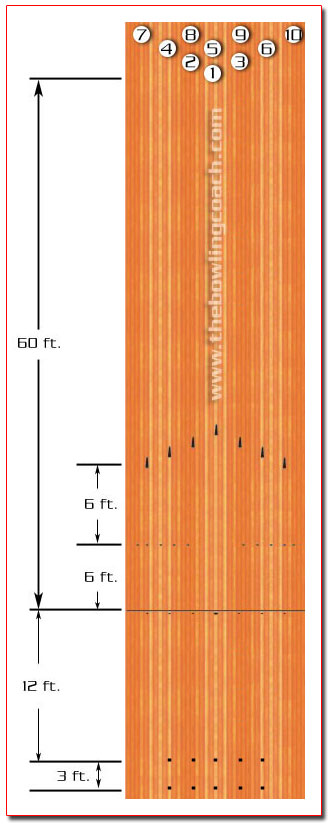BOWLING LANE DIMENSIONS:

BOWLING LANE DIMENSIONS:
Everything You Ever Wanted To Know About the Bowling Lane
A bowling lane is 42 inches wide and 60 feet long, with the length being measured from the foul line to the head pin. Knowledge of these dimensions will have little, if any, influence on your bowling performance. They just define the basic configuration of what you have to work with.
There are a few features about a bowling lane however, that you will eventually find useful. As a beginner, you're most concerned about the pins, and how to get the ball to hit them. Also you'll try to avoid stepping over the foul line. As you start working on your approach, you'll initially experience some problems in getting your footwork right, and having your front foot stopping just in front of the foul line as you release the ball. There are two lines of dots to help you with this. They are called approach dots, with the first set of approach dots located 12 feet from the foul line, and a second set located 15 feet from the foul line. With a little practice, you can use these approach dots to get your footwork and stride just right.
Another set of indicators placed for your use are the arrows. The arrows on the lane are located 15 feet from the foul line, and you use these arrows to help to target where you want to throw the ball. Some bowlers concentrate on the pins, others have learned to focus on a specific arrow, as an aid in getting the ball going in the right direction.
There is yet one more set of indicators you may wish to take advantage of. A 42 inch wide bowling lane contains 40 narrow boards, running the length of the lane. These boards can also be used as target guides if you wish. Most bowlers probably rely on the arrows for reference, but some use specific boards as well. When you consider that your bowling ball has to travel 60 feet, and if you place it an inch or more from where you need to, you'll end up with pins standing instead of getting a strike, or you'll fail to pick up a spare.
So far we've talked about markings that serve as aids to your approach to the lane, and to your placement of the ball. Getting these down pat, particularly the latter, will go a long ways towards determining the skill level you'll attain. An additional factor affecting performance is the oiling of the lane. Oiling the lane not only protects the surface of the lane, but also influences the behavior of the ball as it progresses down the lane. This is of particular importance to the advanced bowler, who relies on the very smallest details to give him or her a competitive edge.
The surface of the bowling lane requires protection, if for no other reason than when a 16 pound ball makes contact, it does so over a very small area. The net result is, that upon contact, the lane receives an impact of a couple of thousand pounds per square inch. In addition, given long periods of heavy use, friction would wear down the surface of the lane if it were not for a protective coating.
The entire lane is normally not oiled, with the final few feet, called the back end, normally left dry. The reason for this is, greater friction exists between the ball and a dry surface, as opposed to that between the ball and an oiled surface. This greater friction enables a ball to hook better as it approaches the pins.
There are a number of different patterns and approaches to oiling a lane, which we won't get into here. One of the problems encountered, is different patterns have different effects upon the behavior of the ball, and consequently have differing effects on the performance the bowler. What is a helpful pattern for one bowler may adversely affect another's performance. The fairest approach appears to be, that for tournament bowlers, different lanes are given different oiling patterns, and as the bowlers constantly change lanes during the course of the tournament, everything evens out.
You might not have known that in the sport of bowling, the characteristics of a bowling lane could make things quite so complicated. Or did you?